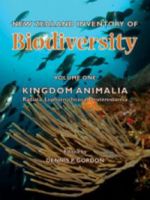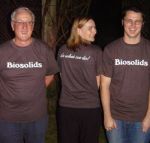Our Changing World for Thursday 13 August 2009
Quantum Nanodots

Jim Johnston and Aaron Small (centre) and some quantum nanodot inks (image: Robert Cross, Victoria University)
Scientists at Victoria University are using the colour-changing properties of quantum nanodots to create novel materials for ink-jet printing. Some of these inks are invisible in ambient light, but fluoresce and change colour under UV light, and could potentially be used for security labelling to protect against counterfeiting. Other inks change colour depending on how light is refracted through the material. Ruth Beran visited Jim Johnston, Aaron Small and Andi Zeller in their lab at Victoria University to find out what a quantum nanodot actually is, and to see some inks of a different colour.
Inventory of Biodiversity
 Ten years ago a large group of scientists began reviewing and creating an inventory of all of New Zealand's life throughout time. The results of that Herculean labour are finally showing fruit, with the launch last month of the first of three volumes of the New Zealand Inventory of Biodiversity (published by Canterbury University Press). Volume one covers three branches of the animal kingdom: Radiata, which includes sponges, comb jellies, and cnidarians (corals, jellyfish and their kin); Lophotrochozoa (shelled and worm-like groups) and Deuterostomes which includes all vertebrates and echinoderms (sea stars, sea eggs), half chordates and sea squirts.
Ten years ago a large group of scientists began reviewing and creating an inventory of all of New Zealand's life throughout time. The results of that Herculean labour are finally showing fruit, with the launch last month of the first of three volumes of the New Zealand Inventory of Biodiversity (published by Canterbury University Press). Volume one covers three branches of the animal kingdom: Radiata, which includes sponges, comb jellies, and cnidarians (corals, jellyfish and their kin); Lophotrochozoa (shelled and worm-like groups) and Deuterostomes which includes all vertebrates and echinoderms (sea stars, sea eggs), half chordates and sea squirts.
To find out more about the astonishing array of animals in the book Alison Ballance visited Andrew Stewart in the fish collection at Te Papa Tongarewa, and caught up with book editor Dennis Gordon at NIWA, the National Institute for Water and Atmospheric Research.
Veronika Meduna spoke with Dennis Gordon about his favourite group of creatures - bryozoa - and process of creating the Inventory of New Zealand life, in February 2009, and in 2007 Dacia Herbulock spoke with Dennis Gordon about the Catalogue of Life project.
New Zealand's Venomous Creatures
It's a dangerous world out there, full of poisonous scorpions, snakes, spiders and a multitude of other creatures that bite, sting and cause pain and even death. And while New Zealand is pretty safe, there are a few venomous animals out there, which is why the National Poisons Centre recently published an article in the New Zealand Medical Journal aimed at doctors, outlining the risks from New Zealand's venomous creatures. Alison Ballance caught up with one of the authors, Poison Information Specialist Leo Schep from the University of Otago's National Poisons Centre, to find out what venomous creatures there actually are in New Zealand, and the best treatment for stings and bites. If you think you've been bitten or stung by a venomous creature contact your doctor, or the Poisons Centre on 0800 POISON
Biosolids

Some lysimeters and a field trial applying biosolids to land (image: ESR)
 Also known as sewage sludge, biosolids are what comes out the other end of wastewater treatment. These materials are nutrient-rich but also contain heavy metals and pathogens. For a number of years, a team at Environmental Science and Research, have been researching the application of biosolids to land, with the aim of producing a range of scientific recommendations for how they could be used. Ruth Beran went to meet ESR's Tom Speir, Jacqui Horswell, and Andrew Van Schaik (pictured from left to right) to find out more about biosolids.
Also known as sewage sludge, biosolids are what comes out the other end of wastewater treatment. These materials are nutrient-rich but also contain heavy metals and pathogens. For a number of years, a team at Environmental Science and Research, have been researching the application of biosolids to land, with the aim of producing a range of scientific recommendations for how they could be used. Ruth Beran went to meet ESR's Tom Speir, Jacqui Horswell, and Andrew Van Schaik (pictured from left to right) to find out more about biosolids.